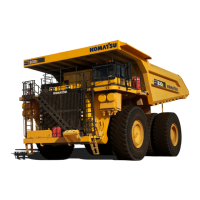B04026 Fuel Tank B4-5
Repair
If a tank has been damaged and requires structural
repair, perform such repairs before final cleaning.
If a tank is to be weld repaired, special precau-
tions are necessary to prevent fire or explosion.
Consult local authorities for safety regulations
before proceeding.
Cleaning
The fuel tank is provided with a drain and a cleaning
port in the side that allows steam or solvent to be uti-
lized in cleaning tanks that have accumulated foreign
material.
It is not necessary to remove the tank from the truck
for cleaning of sediment, however rust and scale on
the walls and baffles may require complete tank
removal. This allows cleaning solutions to be in con-
tact with all interior surfaces by rotating the tank in
various positions, etc.
Prior to a cleaning procedure of this type, all vents,
fuel gauge, and hose connections should be
removed and temporarily sealed. After all scale, rust,
and foreign material has been removed, the tempo-
rary plugs can be removed.
A small amount of light oil should be sprayed into the
tank to prevent rust if the tank is to remain out of ser-
vice. All openings should be sealed for rust preven-
tion.
FUEL GAUGE SENDER
Fuel gauge sender (9, Figure 4-1) is mounted on the
side of the tank provides an electrical signal to oper-
ate the fuel gauge on the instrument panel.
Removal
1. Drain the fuel below the level of the fuel gauge
sender.
2. Disconnect the wires from terminals (18).
3. Remove sender mounting hardware (19). Care-
fully remove the sender and gasket.
Installation
1. Clean the mating surfaces. Install a new gasket.
2. Install the fuel gauge sender in the tank. Ensure
the float is oriented properly and moves freely.
3. Install sender mounting hardware (19) and
tighten the cap screws to the standard torque.
4. Connect the wires to terminals (18).
5. Fill the fuel tank and check for leaks.

